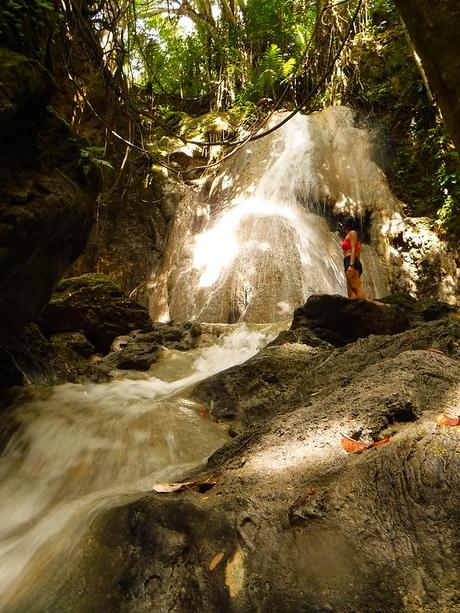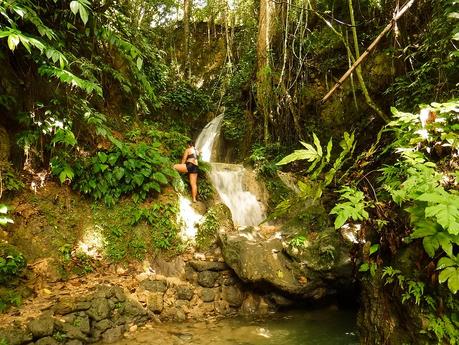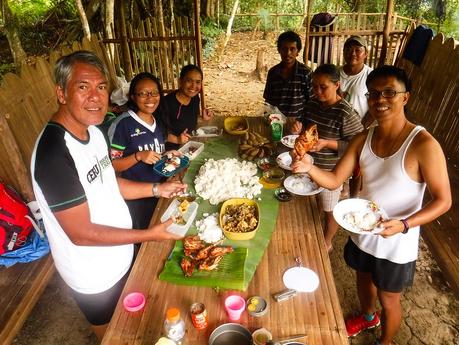
One of the nicest things about hiking the Cebu Highlands Trail is that we encounter unexpected surprises. While trekking to CHT Segment 5‘s exit point in Upper Beceril, Boljoon, we encountered a gentlemen running opposite of us. We said hello to Mr. Ronald Villanueva, Boljoon’s Municipal Budget Officer, who was practicing for an upcoming ultra-marathon. Because we’re kindred spirits in the outdoors, he invited us to have lunch in one of the newest and most beautiful natural attractions—the multi-level Dayhag Waterfalls just a little bit beyond our exit point. Of course, we heartily agreed.
We arrived at Upper Beceril just a little over 12 noon. It was perfect timing because Sir Ronald arrived a few minutes earlier, riding a habal-habal. After a short walk, we arrived at the entrance of Dayhag Falls, marked by a simple shack as well as a welcome sign. It’s a little strange to see a local tourist attraction in the middle of an agricultural area. The nice thing though is that it’s clean and uncrowded.

Dayhag Falls consists of several levels along a river. The first tier is just right along the entrance of the attraction. Yes, you can have a great shower even at the start of visit!
The development of Dayhag Falls started out as a joint project of Boljoon’s Municipal Tourism and Heritage Office as well as the Sangguning Kabataan way back in 2012. Conceived as a “cultural mapping” initiative, the project aims to identify cultural, historical, and natural tourism assets in each barangay in Boljoon. Dayhag Falls is for Upper Beceril.

Each of the waterfall is given a name, in this case, a virtue. Yes, we remember our elementary school days where our class sections were identified with virtues. Or saints. Or animals. Or flowers. Or places.

An established pathway lined with bamboo fences and carefully trimmed plants leads to different areas of the resort as well as the waterfalls. You can’t get lost.
The best thing is that volunteerism was the initial catalyst for the development of the attraction. That’s because initially, there was no budget for the place’s development.

The second waterfall is a little larger and taller than the first waterfall. Here, guests can simply choose which waterfall they want to enjoy with.
Dayhag Falls was discovered by several youths in 2012, and it became a popular albeit remote watering hole. A team of LGU officials later did an ocular inspection and found out that it is a local treasure. Locals then volunteered to clean up the place and develop it into a viable tourist attraction.

Bamboo-and-nipa cottages like these provide guests a place to put down their bags, eat their meals, rest after a refreshing swim, or engage in a fun chat with each other. You can rent these cottages at a reasonable rate.
The good thing is that these structures are built nowhere near the waterfalls or the riverbank. In addition, bringing of food or drinks to any of the tiers is strictly prohibited. As such, the river and waterfalls remain pristine.
The third waterfall is near this cottage, so we decided to visit it last after we return from checking out the other tiers. Since this will be where we will eat our lunch, we put our packs in the cottage, bringing only our cameras and swimwear.

What a great gesture! Sir Ronald and his friends offered us freshly boiled bananas with spicy ginamos (a Filipino condiment made of fermented fish). The slightly sweet taste of the bananas compliment the salty taste of the ginamos. In the Philippines, this pairing is a popular snack.

Following the established trail and negotiating some slippery steps, we came across the fourth waterfall. The rock formations that make up the waterfall look very similar to Aguinid Falls in neighboring Samboan.

In front of the waterfall is a relatively deep pool where you can swim. The water is deep enough so that you won’t hit any part of your body on the riverbed. Don’t dive though—it’s not THAT deep.

For a few hours, you can have your very own tub-and-shower below the fourth waterfall. There’s nothing more refreshing after a hard day’s hike than just relaxing under the water curtain. Yes, Mother Nature gives you her own version of a head, back, and neck massage.

Clean and cool water flows down the river beyond the borders of Dayhag Falls. A healthy forest filters the water flowing down this river. Prohibiting food and garbage, penalizing vandals, constant monitoring, and the absence of structures right by the riverside also helps keep the water sparkling clean.

Next, we went down the fifth and last waterfall. A rickety bamboo bridge leads to a pool just in front and below of the waterfall.

A dose of challenge! To go to the fifth waterfall, you need to climb a small embankment. Be careful, the rocks here are moss-covered and slippery. And if you stay longer than a few seconds on that patch of foliage, a company of forest-borne ants will find your hands and feet a delectable feast.

And there’s the magnificent fifth waterfall with all its glory as the tallest tier in the Dayhag Falls cascade. Have you ever fantasized swimming all by yourself in an enchanted forest? Well, you can definitely do that here! Just check out that beautiful water. Is it even water? It’s like liquid jade!

A huge tree stands guard over the end of Dayhag Falls. This quiet sentinel has been here for years. However, there’s a chance that it might not stand there forever. Check out the roots; those were exposed by constant soil erosion, a natural phenomenon especially in riverbanks.
Someday, this tree will fall. But Nature is all about a balanced cycle, and for sure, a new one will grow.

We headed back to the third waterfall, which is near our lunch area. It’s a small one but no less refreshing than the others. This is the waterfalls for you if you feel lazy. Hehehehe!

A great, natural back massage, anyone? The water felt so good on my shoulders; I’ve been carrying a heavy pack for most of the weekend, you know.

We had our fill of Dayhag Falls, and our tummies were rumbling angrily. When we arrived at the cottage, the delicious smell of grilled chicken made our mouth water. Best of all, this is no ordinary, grocery-bought chicken. This is native chicken, commonly called manok Bisaya. Manok bisaya is a collective term for chickens that are free to roam around the yard, and not confined to a poultry farm.

Manok bisaya is cooked in a variety of ways; here we had it cooked adobo style (boiled in vinegar and soy sauce and laden with spices) and grilled. But however it is prepared, every dish has a common denominator: the meat is firmer and way more flavorful than standard broiler chickens bought in the supermarket.

Bon apetit in slightly rainy weather!

After that fine lunch, it was time to go back to the lowlands so we can catch a ride back home. On the way, our habal-habal drivers showed us the beauty of Boljoon. The municipality has a huge tourism potential.

Thank you very much Sir Ronald and staff for the hearty lunch and for showing us another natural beauty in our amazing island of Cebu. Indeed, Cebu is full of beautiful, unexpected surprises. And these stunning surprises are just waiting for someone with a sense of adventure. So get off the couch and start exploring!

Budget*
Fare
- P 175 per person – bus fare from Cebu to Boljoon Poblacion (fare also applies on the return trip)
- P 50 per person – habal-habal fare from Boljoon Poblacion to Upper Beceril (fare also applies on the return trip)
Entrance Fees
- P 10 per person – below 12 years old
- P 20 per person – 12 years old and above
- P 15 per person – senior citizens and PWDs (persons with disabilities)
- For cottage and amenities rentals, please ask the caretaker in charge
* Rates are subject to change without further notice.
Tips
1. These are prohibited:
- bringing food and drinks to the waterfalls
- diving
- pushing people off rocks
2. Watch your step. Going down to the tiers involves walking down a steep trail of loose rocks, mud, and slippery terrain. The rocks along the river are also slippery and moss-covered, so be careful.
3. Pack light but bring the following:
- water (at least two liters)
- rashguard, swimsuit, cycling shorts, board shorts, and other swimming attire
- extra dry clothes
- trekking sandals or high-quality flip-flops
- umbrella, hat, or sarong
- snacks and beverages
- prepared food or raw ingredients for your meals
- extra clothes
- extra money for emergencies
4. Waterproof your belongings by wrapping them in plastic bags, Zip-lock sandwich bags, dry bags, and other waterproof housings.
5. Preserve the beauty and cleanliness of Bugang River by observing the adventurer’s mantra: take nothing but pictures, leave nothing but footprints, kill nothing but time.

